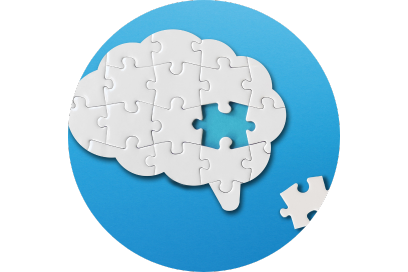
Discover exactly what mentoring in the workplace consists of, its benefits, and how to set up your mentoring programme.
Mentoring is a fantastic route for employees looking to develop skills and advance their careers.
As HR or L&D professionals, you will want to support your people through every step of their journey and mentoring stands to create many benefits.
In this blog, we’ll go through:
- What mentoring in the workplace is plus the types of mentoring
- The benefits of mentoring
- How to set up a mentoring programme
Let’s get started.
💡Pro Tip
We’re experts when it comes to mentoring. Learn more about our mentoring and coaching tool, ThinkLink, to see how you can better create and report on development relationships.
Book a demo to see ThinkLink in action
What is mentoring in the workplace?
Mentoring in the workplace is where a relationship is formed between colleagues to encourage growth and development.
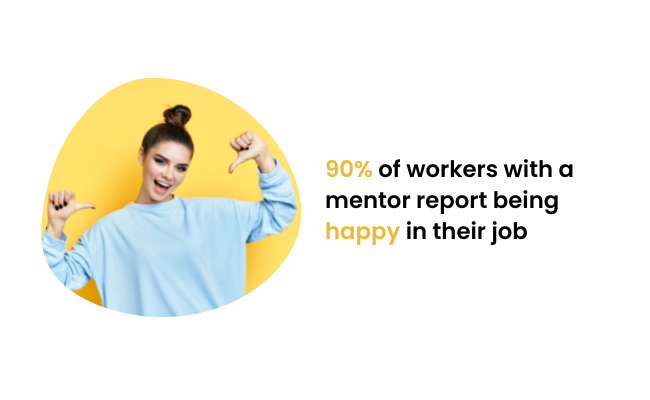
Traditionally, a mentor is a more senior colleague, while the mentee is someone looking to develop skills, their career, or get advice and support.
Informal mentoring is where an employee takes a shine to a colleague and offers to mentor them or ‘take them under their wing’.
These types of mentorships have their benefits, but they don’t ensure that the right people get connected and can sometimes be a little nepotistic.
As such, to avoid any biases, you need to establish formal mentoring to give equal opportunities to your people.
Related: Best mentoring tools and resources to try
What about coaching and sponsorship?
According to Laurie Baedke, there are three different types of relationships in the workplace:
- Mentoring
- Coaching
- Sponsorship
In her book, she defines them as follows:
Mentorship is development oriented;
Sponsorship is advancement oriented;
Coaching is performance oriented.
The difference between each is important, as it gives each different goals, and as a result, different outcomes.
Being aware of this ahead of time can shape how the relationship pans out.
🚀 Pro Tip
Our ThinkLink tool allows you to create any type of relationship with its own set of parameters and rules, giving you complete control of how relationships progress and develop.
Types of mentoring to try out
There are several different types of mentoring, usually:
- One-on-one mentoring
- Peer mentoring
- Group mentoring
- Reverse mentoring
Let’s go through these in a bit more detail.
One-on-one mentoring
This is the most typical type of mentoring that probably comes to mind. It’s a traditional model where one mentor and one mentee enter a mentorship to help the mentee develop and grow in their role.
In this type of mentoring, the mentor will have more experience in an area that the mentee is interested in, whether that’s career, leadership, or general skills.
Of course, the focus is on the mentee, but the mentor will also benefit as they develop skills like leadership, prioritisation, and communication.
This type of mentoring usually encourages a more long-term relationship which can have a huge impact on confidence, motivation, development, and even mental health.
As mentioned earlier, this can be broken down into formal and informal mentoring.
Formal mentoring has specific objectives and measurable outcomes. Meanwhile, informal mentoring is more organic and usually happens as a result of a pre-existing relationship between two employees.
Peer mentoring
Peer mentoring is where two people come together in a mentorship but both are a similar level or age range.
As such, it’s not about passing down knowledge and experience, it’s more about sharing similar experiences and the learning taken from those experiences.
This type of support usually works best as part of onboarding, or more specific initiatives like employees coming back from parental leave.
Group mentoring
This type of mentoring is where a mentor will work with a number of mentees as part of one group.
The mentor will lead sessions and all the mentees will share their own experiences and knowledge.
This type of mentoring is good at impacting more mentees in a shorter period, but of course, it means there’s less individual impact.
It’s often used as a way of upskilling groups, creating knowledge-sharing routes, or bringing separate teams together.
Reverse mentoring
This is where a more junior person mentors a more senior colleague in an organisation.
This type of mentoring recognises there are skills gaps on both sides of a mentoring relationship. The most common use of this type of mentoring is to upskill senior employees on digital technology that junior colleagues will pick up more naturally.
All mentoring has the potential to utilise reverse mentoring as there are always skills and experiences one person will have that another won’t. But this type of program formalises that.
What are the benefits of mentoring?
There are a wide range of benefits available with mentoring. And it’s not just the mentee who stands to gain something from a mentoring programme.
Mentoring can positively impact everyone involved, including the organisation.
It can help create a strong company culture, improve mental health, and help career progression.
But, let’s break down the benefits for:
- Mentees
- Mentors
- Organisations
The benefits of mentoring for a mentee
There are a lot of benefits for a mentee that go beyond career development.
Mentees can benefit from mentoring with:
- Increased confidence
- Better communication
- Expanded networks within the company
- Improved goal setting
- Better prioritisation
- Increased career development
- Increased job satisfaction
- Improved mental health
The benefits of mentoring for a mentor
Mentors are often hailed for ‘giving back’, but the truth is that they also stand to gain a lot from mentoring.
Mentoring can benefit a mentor with:
- Increased confidence
- Improved leadership skills
- Better communication
- Feedback
- Being a better listener
- Paying it forward
- Promoting knowledge sharing
- Exposure to new perspectives
How mentoring can benefit an organisation
It’s not just the mentor and mentee that stand to gain something. The organisation running the mentoring programme also stands to benefit.
Mentoring can benefit organisations by:
- Improving employee engagement and satisfaction
- Increasing retention rates
- Improving promotion rates
- Attracting talent
- Increased productivity
- Better communication
Of course, a lot of these benefits feed into one another too. For example, increasing employee engagement can lead to increased productivity and better retention.
Improving the above can help you streamline your L&D strategy.
How to set up a mentoring programme in the workplace
Setting up a mentoring programme doesn’t have to be a struggle of spreadsheets and busy work.
Related: Complete guide to building mentoring programmes
To keep things simple, we’re going to show you how to set up a mentoring programme using our own mentor-matching tool, ThinkLink.
The process works a little like this:
Step 1 – Create your relationship type
In ThinkLink, you have control over each facet of your relationship builder, meaning you can define how users engage with each other, and the parameters of the relationship within your LMS.
Related: What exactly is an LMS?
You can set up different relationships like mentoring, coaching, or sponsorship.
You can also control:
- Users based on team level or location
- Who’s allowed to request a relationship
- Who can create logs in the diary
- Who can see the diary logs
We’ll get onto the diary logs in a moment.
The level of configuration gives you complete control of how you manage your mentoring programme. It means you can set up concurrent schemes for example mentoring and onboarding.
Step 2 – Search your users
Once your system is all setup, it’s ready to use.
Since you’ll have set up permissions in the backend, your set audiences can now engage with ThinkLink.
Here, they’ll be able to search through colleagues based on skills. As opposed to having to trawl through long lists of users, they can search for skills to find the best fit.
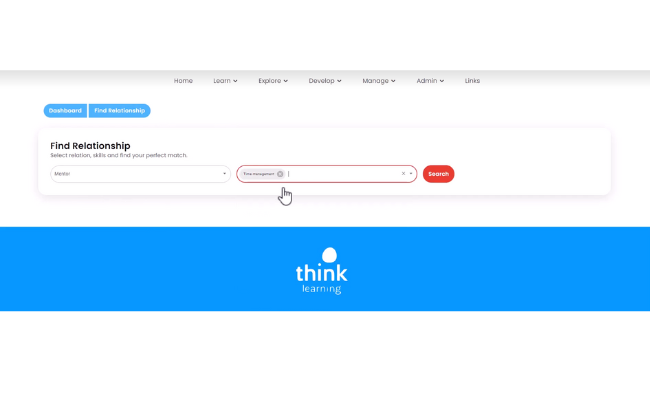
Step 3 – Request relationship
When your mentee finds a suitable mentor, they can then request a relationship.
Requests will then sit as pending in the mentee’s dashboard.
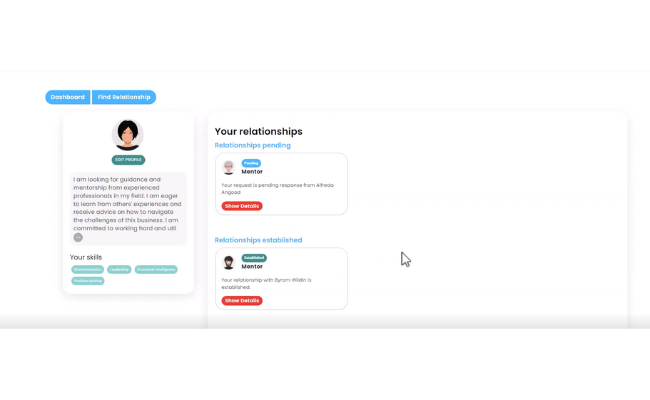
⚙️ Note
Of course, this shouldn’t replace an organic, offline conversation. But requesting a relationship allows you to kickstart the conversation and acts as a facilitator to open access to members of staff you previously may not engage with.
Here, a user can manage their requests (both inbound and outbound) and can have multiple relationships running concurrently.
As an admin, you can get an overview of who is mentoring/coaching who, for easy management.
This is where congratulations are in order! Your mentors and mentees are matched and are beginning their journey.
Step 4 – Monitor progress
Now your mentors and mentees are matched, there are a bunch of tools they can make the most of to record their sessions and any impact.
ThinkLink offers a diary tool for users to fill in (based on your configuration). Here, your people can log meetings and notes.
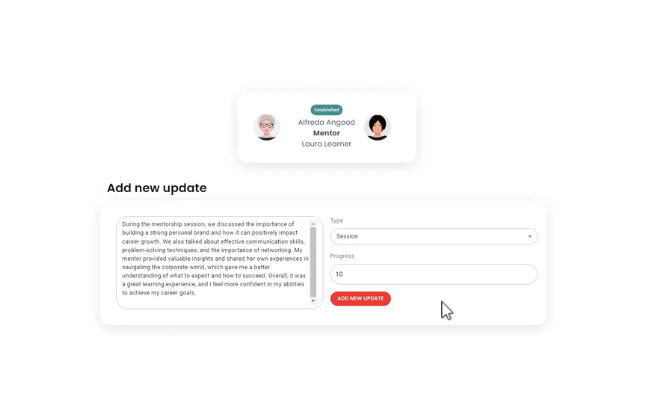
As an admin, you can view these logs to keep track of momentum.
Step 5 – Report on success
When your mentorships are over, you have all of the data you need right at hand in your LMS.
You don’t have to worry about chasing extra feedback, you can integrate 360 feedback into your mentoring process to better understand progress and impact.
This makes writing impact reports much easier!
Build mentors in the workplace with Think
And there you have it. A quick overview of mentoring in the workplace and how Think can help you effectively create a mentoring programme.
If you’re looking to integrate mentoring into your LMS, or just into your learning strategy, then get in touch.
We can show you the key features of ThinkLink and how they work together to create a seamless mentor and coaching function.
Book a demo now to speak to one of our experts and see the tool in action.


